Boas!
Resta saber é se esses "K" são algo de jeito...
Espero que seja para justificar o investimento...
Cumprimentos,
LPC
User Tag List
 Likes: 4
Likes: 4
Resultados 781 a 795 de 1604
-
06-07-15, 17:01 #781O Administrador


- Registo
- Mar 2013
- Local
- Multiverso
- Posts
- 17,814
- Likes (Dados)
- 74
- Likes (Recebidos)
- 156
- Avaliação
- 31 (100%)
- Mentioned
- 31 Post(s)
- Tagged
- 0 Thread(s)
My Specs: .....

CPU: AMD Ryzen 7 5800X3D :-: Board: MSI B550M BAZOOKA :-: RAM: 64 GB DDR4 Kingston Fury Renegade 3600 Mhz CL16 :-: Storage: Kingston NV2 NVMe 2 TB + Kingston NV2 NVMe 1 TB
CPU Cooling Solution: ThermalRight Frost Commander 140 Black + ThermalRight TL-C12B-S 12CM PWM + ThermalRight TL-C14C-S 14CM PWM :-: PSU: Corsair HX 1200 WATTS
Case: NZXT H6 FLOW :-: Internal Cooling: 4x ThermalRight TL-C12B-S 12CM PWM + 4x ThermalRight TL-C14C-S 14CM PWM
GPU: ASUS TUF AMD RADEON RX 7900 XTX - 24 GB :-: Monitor: BenQ EW3270U 4K HDR
-
15-07-15, 16:20 #782Tech Ubër-Dominus


- Registo
- Nov 2013
- Local
- City 17
- Posts
- 30,121
- Likes (Dados)
- 0
- Likes (Recebidos)
- 2
- Avaliação
- 1 (100%)
- Mentioned
- 0 Post(s)
- Tagged
- 0 Thread(s)
Intel’s Xeon Phi 14nm ‘Knights Landing’ Co-Processors Detailed – OmniPath Architecture 100 Series and 16GB HMC on a 2.5D Interposer
Intel has already revealed most of the big points of the upcoming Knights Landing platform earlier this year. However, Intel will be volunteering more information about the OmniPath Architecture used in its Xeon Phi products at the International Supercomputing Conference 2015 (ISC 2015). The Xeon Phi family of products is Intel’s (apparently successful) foray into the GPGPU sector or the world of extensively parallel data processing. The Co-Processors will be deploying commercially later this year.

Intel talks about Knight’s Landing Omni Path 100 Series Architecture
Knight’s Landing was built on the 14nm Process and uses modified silvermont cores (x86 ofcourse). It is also one of the first mass produced components developed for this market segment that features stacked DRAM (short of AMD’s Fury lineup, which doesn’t really count here). Since the GPU form factor is usually limited (to heck) by the PCI-E lane, an alternative CPU form factor is also provided which gives super-low latency and almost no bottlenecks. The on-packed stacked DRAM will come in a whooping 16 GB while there are connections for additional DDR4 2400Mhz memory. Keep in mind that we are talking about a socket-able, packaged processor here, not just a GPU sized product.
The HMC will not actually be placed or stacked upon the die. Using the 2.5 D stacking that should now be pretty familiar for our readers, Intel will actually be surrounding the Xeon Phi die using a Micron-Intel custom made, super-high bandwidth, parallel path interface that will make the HMC appear as if its on the die. Infact it will act more or less like an L3 cache worth 16GB. The Hybrid Memory Cube used in the Knights Landing Xeon Phi package will feature upto 2000 TSVs and an ASIC at the base of the HMC to manage the DRAM package. It promises more than 5 times the bandwidth of DDR4 RAM and more than 15 times the bandwidth of DDR3 Ram. Because Intel is using a customized Micron 16GB HMC solution (they already have 2GB and 4GB variants) and a customized interface the bandwidth will be 500GB/s.

The Knight’s Landing ‘Xeon Phi’ Co Processor will have upto 72 cores, something Intel has once again confirmed. This is actually pretty decent news, because for once Intel seems to be having good luck when it comes to Yield. Its predecessor were only able to chug out Knight’s Corner with around 61 cores. While I am sure there will be variants with cut down cores, there will also be variants with the full 72 cores. A point I might add is the number of cores can be misleading. These are cores based on the Silvermont architecture and nowhere near as powerful as the the cores deployed in the mainstream desktop market. Still, they will be able to pack a punch of upto 3 TeraFlops which is efficient enough given the electric footprint.
And ofcourse, the biggest advantage is that this is a co-processor. Unlike a GPU running GPGPU applications, which requires a CPU to direct its workload, a Co-Processor requires no such direction and is completely independent. The downside is that it needs more customized software to effectively utilize it. The Omni Path 100 Series as Intel now calls it is an attempt at vertical integration and expanding into the market occupied by Infiniband. As you can clearly tell from the PR material, Intel is showcasing its Omni-Path interconnect as a significantly superior alternative to InfiniBand. Each Knight’s Landing product will have 2 ports for the Omni-Path connectors. The exact release date of this product is not known but it is thought to be sometime later in this year.
-
16-07-15, 16:35 #783Master Business & GPU Man


- Registo
- Jan 2015
- Local
- País Campeão Euro 2016
- Posts
- 7,793
- Likes (Dados)
- 0
- Likes (Recebidos)
- 1
- Avaliação
- 41 (100%)
- Mentioned
- 0 Post(s)
- Tagged
- 0 Thread(s)
http://www.guru3d.com/news_story/int...n_to_2017.html
Assim vai dá tempo para juntarmos os trocos para o 6700K..................Ideias sem Nexo e Provas do Tráfico de Hardware
"que personifica o destino, equilíbrio e vingança divina." Dejá vú. Que cena!
-
31-07-15, 12:28 #784Tech Ubër-Dominus


- Registo
- Nov 2013
- Local
- City 17
- Posts
- 30,121
- Likes (Dados)
- 0
- Likes (Recebidos)
- 2
- Avaliação
- 1 (100%)
- Mentioned
- 0 Post(s)
- Tagged
- 0 Thread(s)
Intel divides desktop market into six segments
Noticia:In a bid to offer the right solutions for different classes of desktop personal computers, Intel Corp. recently presented its vision of desktop platforms to makers of PC components. Apparently, the world’s largest maker of microprocessors sees as many as six distinctive segments of today’s desktop market.
Sales of personal computers have been declining for a number of quarters already due to various reasons. As a result, in order to maximize sales of PCs, microprocessors and other devices, manufacturers need to offer tailored solutions that bring maximum value to the end-user. Intel believes that there are six segments of the desktop market that it needs to address with its current and upcoming microprocessors, reports DigiTimes.
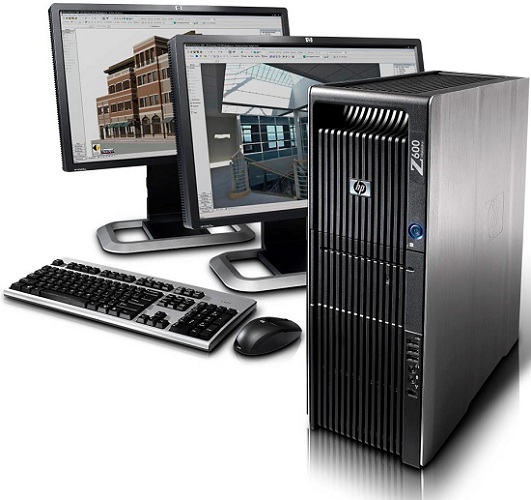
- Enthusiast – PCs powered by Intel Core i7 processors and used for gaming, audio/video content creation and other tasks that require a lot of compute performance.
- Mainstream – PCs based on Core i5 and Core i3 processors that offer great price-performance ratios.
- All-in-one (AIO) – Systems featuring various energy-efficient processors and rich multimedia capabilities.
- Mini PCs or NUCs [next unit of compute] – Small form-factor computers with low-power Atom, Celeron, Core or Pentium microprocessors. Such computers can be used for various purposes and can run Microsoft Windows 10 or Google Chrome operating systems.
- Desktop replacement notebooks (portable AIO PCs) – High-performance personal computers in clamshell form-factors that are based on Core i7 or Core i5 microprocessors with 47W – 57W thermal design power.
- Compute sticks – Ultra small form-factor personal computers based on highly-integrated ultra-low-voltage system-on-chips. Such devices may also use both Microsoft Windows 10 and Google Chrome operating systems
Intel already offers a broad portfolio of processors, core-logic sets and solid-state storage devices for each type of desktops. However, going forward the chip giant might decide to offer certain bundles in a bid to decrease prices of systems while ensuring its own sales.
It is interesting to note that Intel reportedly considers segments of advanced desktops, NUCs and compute sticks as the most promising in terms of growth.
Intel did not comment on the news-story.
http://www.kitguru.net/desktop-pc/an...ate-solutions/
-
26-08-15, 16:33 #785Tech Ubër-Dominus


- Registo
- Nov 2013
- Local
- City 17
- Posts
- 30,121
- Likes (Dados)
- 0
- Likes (Recebidos)
- 2
- Avaliação
- 1 (100%)
- Mentioned
- 0 Post(s)
- Tagged
- 0 Thread(s)
Intel reveals details of its Omni-Path Architecture interconnect
Noticia:One of the toughest challenges in computing is building large-scale systems like those used in the world of high-performance computing (HPC). Currently, such systems typically communicate between nodes over an interconnect like Ethernet or Infiniband, but Intel intends to replace those technologies with a new interconnect known as Omni-Path Architecture. This week at the Hot Chips conference, the firm is unveiling detailed information about how Omni-Path works and how it will be deployed alongside Intel's other products.
Omni-Path is interesting in part because of the intense difficulty of the problem it has to address: allowing the hundreds or thousands of nodes in a supercomputer to communicate with one another at high speed while keeping delays at a minimum. Intel says Omni-Path is meant to scale from "small clusters to the largest supercomputers." To make that happen, the chipmaker has taken on the task of designing nearly every piece of the puzzle needed to establish a new interconnect fabric, from the host adapters to switches, software, and tools. Some of the core technology comes from Intel's acquisition of InfiniBand IP from Cray, and other bits come from its acquisition of a company called True Scale. Much of the software comes from the existing Open Fabric Alliance. At the end of the day, though, Omni-Path looks to be Intel's own product and very much a rival for other standards—and for products from firms like Mellanox.
Omni-Path has an inside line because it comes from Intel, maker of the Xeon lineup—the dominant CPUs in the data center—and of the Xeon Phi parallel processor. The first Omni-Path products will include discrete host adapters that fit into PCIe slots, but Intel plans to integrate Omni-Path connectivity on to the same package as the Xeon and Xeon Phi—and eventually directly into the processors' silicon. The purported benefits of this integration will be familiar to anyone who's been watching CPUs in the past ten years: lower point-to-point latency thanks to the elimination of a chip-to-chip "hop" in the network, lower power use, a smaller physical footprint, and, of course, lower overall costs. Integration also has the side-effect of making life very difficult for competing interconnect standards that are not integrated into the processor.
At a press preview event during last week's Intel Developer Forum, we got a first look at an Omni-Path host adapter in the form of a PCI Express x16 card. This card has a single port onboard and can support transfer rates up to 100 Gbps. Cards based on this Intel network chip can have one or two ports. The single-port cards will require up to 8W of power, while the dual-port versions can use up to 12W.
Omni-Path supports four "lanes" per connection, and each of those connections has a 25 Gbps transfer rate, for 100 Gbps in aggregate. Those connections can happen over optical links or over copper cables up to three meters in length. Even though it's a next-generation interconnect, Omni-Path supports copper cabling in order to keep costs in check.
Most of Omni-Path's unique magic happens at the lowest layers of the network stack, traditionally known as layers 1 and 2 in the OSI model. Above that, the interconnect will support existing transport and application standards.
The most interesting innovation in Omni-Path may be the insertion of a layer "1.5," known as a link transport layer or LTL, that grew out of work formerly being done at Cray on the Aries interconnect. According to Omni-Path Chief System Architect Phil Murphy, this additional layer breaks packets into 65-bit units known as "flits," and set of 16 flits together with a CRC comprises a packet. Busting packets into smaller units gives Omni-Path the ability to keep transfer latencies low by allowing high-priority packets to pre-empt large, low-priority packets that "we've already started putting on the wire," in Murphy's words. Flits from different packets can be interleaved with one another as needed in order to make sure that critical messages reach their destinations as quickly as possible. Which is very slick.
I'm barely scratching the surface here. If you'd like more info, Intel has released a paper on the OPA fabric, but you have to register at this website in order to download it. I believe IEEE Spectrum will be publishing an even more detailed paper on Omni-Path, as well.
This interconnect is clearly aimed at a particular mission in a relatively small but lucrative market. Still, the fact that Intel intends to integrate this tech into its CPUs immediately raises intriguing prospects for future uses of this technology—or something very much like it—as part of future system architectures generally, which makes it very much worth watching.
http://techreport.com/news/28908/int...e-interconnect
-
26-08-15, 16:43 #786Tech Ubër-Dominus


- Registo
- Nov 2013
- Local
- City 17
- Posts
- 30,121
- Likes (Dados)
- 0
- Likes (Recebidos)
- 2
- Avaliação
- 1 (100%)
- Mentioned
- 0 Post(s)
- Tagged
- 0 Thread(s)
The Intel Broadwell Xeon E3 v4 Review: 95W, 65W and 35W with eDRAM
Toda a review:
Our Broadwell coverage on the desktop has included reviews of the two consumer processors and a breakdown of IPC gains from generation to generation. One issue surrounding Broadwell on consumer platforms was that the top quad-core model was rated at one third less power in comparison to previous Intel quad core processors. Specifically, Broadwell is 65W against 84-95W in past generations. This puts Broadwell’s out-of-the-box peak performance at a TDP (and frequency) disadvantage. However in a somewhat under-the-radar launch, Intel also released a series of Broadwell Xeons under the E3-12xx v4 line. We sourced three socketed models, the E3-1285 v4 at 95W, the E3-1285L v4 at 65W and the E3-1265L v4 at 35W to get a better scope of Broadwell's scaling across different power requirements.
Broadwell Xeon Overview
In almost every sense of the word, the launch of Broadwell in a socketed format has been fairly muted. For low-power mobile platforms at 4W and 15W, Broadwell was promoted heavily and the architecture has had many design wins; but for the desktop only two socketed consumer parts were launched. To that end, Intel performed only post-launch sampling for review websites, resulting in many users learning about the performance much later after the official launch (AnandTech had you covered on day one!). Even now, several weeks later, the i7-5775C and i5-5675C are both hard to source in several regions. Complicating matters is that Intel’s platform after Broadwell, Skylake, was launched soon after in early August with a bigger focus on gaming and end-user experiences, as well as the announcement of the Skylake Xeon family integrating into dedicated mobile processors. This has the effect of resigning Broadwell on the desktop to obscurity, whether intentionally or not (cue the conspiracy theorists).
The crumb of comfort in Broadwell is its use of 128MB of eDRAM. This acts as a fully associative last level victim cache (or L4) for the processor, and speeds up certain workloads that are memory dependent and subject to L3 cache misses when data has been previously evicted. This is a narrow double-pumped serial interface capable of delivering 50GB/s bi-directional bandwidth (100GB/s aggregate). Access latency after a miss in the L3 cache is 30 - 32ns, nicely in between an L3 and main memory access. The major benefit in our testing was to the integrated graphics, giving Intel the best integrated graphics in a bit socketed platform where money is no cost. Some reviews also saw that the eDRAM helped in discrete graphics gaming as well, although at a small effect and highly game dependent (but this raises other issues regarding higher performance on lower power/frequency processors with more on-package memory). The main downside of the eDRAM however is that it is CPU resident, not visible from the system agent to the DRAM, and thus only accessible to CPU/GPU workloads rather than accelerating data over the system IO.
What went further under the radar was the Intel Broadwell platform Xeons for the business and server market. We reported on its launch, but there was seemingly nothing front facing about the marketing of these processors, suggesting Intel might be keeping them as a pure business-to-business product. All bar one of these processors also support the eDRAM but also several Xeon-specific features. Back with Haswell, Intel launched a single soldered (BGA) Xeon with eDRAM. By having three socketed variants (LGA) for Broadwell at ‘launch’, it satisfies business customers that want to upgrade from Haswell E3 v3 Xeons but also provides business environments and server environments with the use of that eDRAM. One of the cited uses for it includes active memory databases, giving fewer cache misses by having a larger chunk of faster memory closer to the processing cores.
All the Broadwell Xeons are quad core with hyperthreading, with all bar one having Iris Pro P6300 (the professional version of Iris Pro 6200) on 48 EUs/GT3e. All but one soldered part has the eDRAM disabled. (Note that the E3-1284L v3 is listed by CPU-World but not currently listed at ark.intel.com.) Aside from this, the models differ solely on the basis of processor frequency, graphics frequency and thermal design limits. It is interesting to note the differences between the E3-1285 v4 and the E3-1285L v4. Sitting at 95W and 65W respectively, that 30W difference in TDP is represented by only a 100 MHz difference in the base frequency. This is relatively odd, and suggests that the 65W part, the E3-1285L v4, is a better off-the-wafer part with preferred frequency/voltage characteristics which also costs almost $100 or ~20% less. This plays a significant part in our testing.
The eDRAM stands out compared to previous Xeons, although at the expense of 2MB of L3 cache compared to previous high end quad core models (or i7 equivalents). Some microprocessor analysts have said that the loss of 2MB of L3 is not that important when backed up by 128MB of a fast L4 type of cache, on the basis that the bandwidth of this L4 is 50GB/s and up before you hit main memory.
Why eDRAM?
In a recent external podcast, David Kanter mentioned that for a multiple increase in cache (e.g. 3x), cache misses are decreased on average by the square root of the multiple increase (e.g. √3, or 1.73, 73%). So the movement from 8MB of last level cache to 128MB + 6MB, and despite the minor increase in latency moving out to eDRAM, is an effective 16x increase, reducing cache misses by a factor of four. This means, to quote, ‘if you have eight cache misses per thousand, you are now down to around two’ – I take this to mean a regular user workload but in a higher throughput environment, it could mean the difference between 2% and 0.5% cache misses out to main memory. Because the move out to main memory is such a latency and bandwidth penalty compared to an on-package transfer between the CPU and L3/L4, even a small decrease in cache misses has performance potential when used in the right context. Anand quoted Intel’s Tom Piazza back in our Haswell eDRAM review about the size of the eDRAM, and it was stated that 32MB should be enough, but it was doubled and then doubled it again just to make sure, as well as ‘go big or go home’. This has knock on performance effects.
Users upgrading to Broadwell Xeons from Haswell (or those purchasing new systems outright) will get this eDRAM benefit and a lower cost than previous Xeons – the E3-1285L v3 from the Haswell architecture was launched at a price of $774, compared with the E3-1285L v4 which is $445. For the difference, the Broadwell processor comes with eDRAM, substantially better integrated graphics and all within the same thermal design. At 95W, this difference is from $662 to $556, a much smaller difference. This suggests that on Haswell, the lower power model was harder to produce, whereas with Broadwell that burden shifts on the frequency.
Graphics Virtualization and Upgrades
One of the benefits of the Broadwell Xeons with eDRAM lies in Intel's graphics virtualization technology (GVT). This affords three modes of operation:
The benefits of these virtualization techniques allow data centers to essentially apply an accelerant to each VM depending on the beneftis of the GPU on each workload. With it being directly included in the CPU, no additional hardware is needed. Obviously this makes more sense when each virtual machine requires infrequent access to the integrated graphics, but for everything else, Intel is set to launch it's Valley Vista platform which will adorn three of these CPUs onto an add-in PCIe card.
Valley Vista
At IDF San Francisco this year, an announcement passed almost everyone by. Intel described an add-in card coming in Q4 2015 that features three Broadwell-H E3 Xeon processors on a single PCB, each with Iris Pro graphics.
Valley Vista is designed to allow for high density, workload specific work, in particular AVC transcoding. Aside from the slide above, there has been no real details as to how this card will work - if there's a PCIe switch for communication, or if it runs in a virtualized layer, or how the card is powered or if each of the processors on the card will have a fixed amount of DRAM associated with them. So far Supermicro announced in a press release that one of their Xeon Phi platforms is suitable for the cards when they get launched later this year. What we do know however is that Broadwell is not fully HEVC accelerated, so the utility in Valley Vista is most likely to be with AVC encode/decode.
Chipsets
As with previous socket drop-ins on the professional line, Intel is promoting the use of its C226 chipset - for our testing, we used an equivalent Z97 platform which worked as well.
This provides an as-is scenario, with sixteen lanes of PCIe 3.0, two channels of DDR3/L-1600 memory with ECC support, a DMI 2.0 x4 link equivalent to 4 GB/s, up to six native USB 3.0 and SATA 6 Gbps ports, depending on the high-speed IO configuration used in the chipset in conjunction with the eight PCIe lanes.
This Review
There isn’t much else to say here – we have covered Broadwell on the desktop and the differences are spelled out for end users despite the current lack of direct availability in certain markets at this time. These are Xeon processors, so no overclocking here, but the main parallel we should be making is the 95W of the E3-1285 v4 and the E3-1276 v3 at 84W. The E3 has some extra frequency (peaks at 4 GHz) and extra L3 cache, but the Xeon has eDRAM.
Compared to Johan’s in depth server reviews, the focus for the testing on this piece is primarily at workstation environments. Because we did not get a 95W ‘consumer’ based Broadwell for comparison, gaming tests were also performed. Unfortunately the Linux based server tests we typically use were not performed due to a spectacular failing of our Ubuntu LiveCD with these processors, even though it worked with the non-Xeon counterparts. We’re still trying to figure this one out but we suspect it is a driver related issue. While in no way similar, in its stead we have SPECviewperf 12 on Windows with a discrete GPU (it's typical use case) as an additional angle of comparison.
A side note to those have recently asked - we are in the process of looking into appropriate repeatable compilation benchmarks and VM environment comparisons. Ideally we are aiming to finalize a series of tests that can be one-click batched and processed within a reasonable testing timeframe. These will not be ready until mid-September at the earliest due to other commitments, but when available we will try and run a number of past systems to acquire appropriate comparative data. To add comments, suggestions or preferences on the tests, please email ian@anandtech.com.
Test Setup
The dynamics of CPU Turbo modes, both Intel and AMD, can cause concern during environments with a variable threaded workload. There is also an added issue of the motherboard remaining consistent, depending on how the motherboard manufacturer wants to add in their own boosting technologies over the ones that Intel would prefer they used. In order to remain consistent, we implement an OS-level unique high performance mode on all the CPUs we test which should override any motherboard manufacturer performance mode.Test Setup Processor Intel Xeon E3-1285 v4 95W 4C/8T 3.5 GHz / 3.8 GHz Broadwell Intel Xeon E3-1285L v4 65W 4C/8T 3.4 GHz / 3.8 GHz Broadwell Intel Xeon E3-1265L v4 35W 4C/8T 2.3 GHz / 3.3 GHz Broadwell Motherboards MSI Z97A Gaming 6 Cooling Cooler Master Nepton 140XL Power Supply OCZ 1250W Gold ZX Series Memory G.Skill RipjawsZ 4x4 GB DDR3-1866 9-11-11 Kit Video Cards ASUS GTX 980 Strix 4GB
MSI GTX 770 Lightning 2GB (1150/1202 Boost)
ASUS R7 240 2GBHard Drive Crucial MX200 1TB Optical Drive LG GH22NS50 Case Open Test Bed Operating System Windows 7 64-bit SP1
All of our benchmark results can also be found in our benchmark engine, Bench.
Many thanks to...
We must thank the following companies for kindly providing hardware for our test bed:
Thank you to AMD for providing us with the R9 290X 4GB GPUs.
Thank you to ASUS for providing us with GTX 980 Strix GPUs and the R7 240 DDR3 GPU.
Thank you to ASRock and ASUS for providing us with some IO testing kit.
Thank you to Cooler Master for providing us with Nepton 140XL CLCs.
Thank you to Corsair for providing us with an AX1200i PSU.
Thank you to Crucial for providing us with MX200 SSDs.
Thank you to G.Skill and Corsair for providing us with memory.
Thank you to MSI for providing us with the GTX 770 Lightning GPUs.
Thank you to OCZ for providing us with PSUs.
Thank you to Rosewill for providing us with PSUs and RK-9100 keyboards.
Load Delta Power Consumption
Power consumption was tested on the system while in a single GTX 770 configuration with a wall meter connected to the OCZ 1250W power supply. This power supply is Gold rated, and as I am in the UK on a 230-240 V supply, leads to ~75% efficiency > 50W, and 90%+ efficiency at 250W, suitable for both idle and multi-GPU loading. This method of power reading allows us to compare the power management of the UEFI and the board to supply components with power under load, the power delta from idle to CPU loading, and all results include typical PSU losses due to efficiency.
Power numbers are typically difficult to gauge as they depend on the stock voltage of the processor and how aggressive the motherboard wants to be in order to ensure stability. If I were thinking from the point of view of the motherboard manufacturer, they are more likely to overvolt a Xeon processor to ensure that stability rather than deal with any unstable platforms. As a result, we get an odd scenario where the 35W processor is almost hitting double the power consumption at load, and the 65W is also above its mark, but the 95W is below. To put an angle on this, the 110W we see on the i7-6700K was in one motherboard, but in another we have seen 76W as well as 84W. Without having access to the BIOS DVFS tables for each processor, it is difficult to tell when we have mismatched data such as this.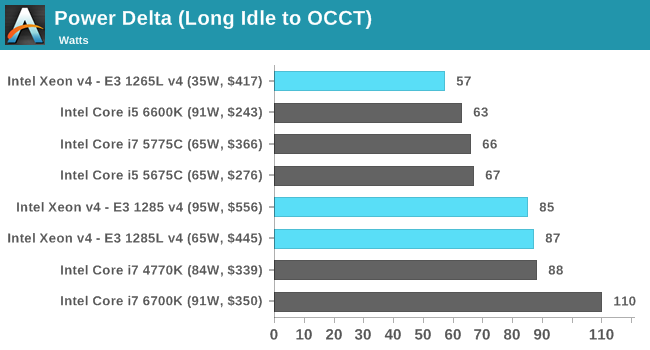
http://www.anandtech.com/show/9532/t...285-1285l-1265
-
27-08-15, 20:45 #787Tech Ubër-Dominus


- Registo
- Nov 2013
- Local
- City 17
- Posts
- 30,121
- Likes (Dados)
- 0
- Likes (Recebidos)
- 2
- Avaliação
- 1 (100%)
- Mentioned
- 0 Post(s)
- Tagged
- 0 Thread(s)
Don't call it Knots Landing: next Xeon Phi detailed
Noticia:Intel's sequel to Knight's Corner is more than just a fresh coat of paint. We've been hearing about the Xeon Phi successor for a while now, and the company released a torrent of new information at Hot Chips, detailed by Serve The Home.
Knights Landing-based Xeon Phis (Xeons Phi?) are built using tiles. A tile contains a pair of x86 cores based on the Silvermont microachitecture with customizations for HPC. Each core has 1MB of L2 cache and can track and execute four hardware threads. Within every core is a pair of vector processing units (totaling four per tile) that can be programmed using the AVX-512 instruction set extensions.
The Xeon Phi uses 36 of these tiles connected by a 2D mesh interconnect for a total of 72 cores, 144 VPUs, and 288 hardware threads. Intel then heaps on 16GB of on-package multi-channel DRAM (MCDRAM), which is Intel's high-bandwidth memory technology and not to be confused with AMD's HBM solution. The processor can also has a six-channel DDR4-2400 memory controller for when 16GB isn't enough.
Much like previous the previous models in the family, Intel is pimping the Xeon Phi's x86 compatability as a big bonus over competing solutions like Nvidia's Tesla or AMD's FirePro compute cards. Multiple Xeon Phi processors can be strung together, talking to each other over PCI-express or the Omni-Path Architecture fabric.
We already know about the US Department of Energy's supercomputer project. Now that the latest Xeon Phi family has been announced, we expecte more such projects will be on the way.
http://techreport.com/news/28920/don...n-phi-detailed
-
09-09-15, 08:05 #788Tech Ubër-Dominus


- Registo
- Nov 2013
- Local
- City 17
- Posts
- 30,121
- Likes (Dados)
- 0
- Likes (Recebidos)
- 2
- Avaliação
- 1 (100%)
- Mentioned
- 0 Post(s)
- Tagged
- 0 Thread(s)
Intel Broadwell-E Scheduled For Launch in Q1 2016 – Will Feature 8 and 6 Core SKUs, Retaining Support on X99 Platform
Intel was previously rumored to start mass production of their Broadwell-E processors in Q1 2016 but now a report from BenchLife seems to point out that Intel will also launch their flagship processors during the same quarter. The Broadwell-E platform which comprises of X99 based motherboards and Broadwell architecture based 8 to 6 core processors will be the latest addition to Intel’s HEDT (High-End Desktop) lineup.

Intel Broadwell-E HEDT Platform Scheduled for Q1 2016 Launch
The schedule for Broadwell-E reveals that ES sampling of the processors will commence in Q4 2015 followed by QS sampling that will mark the transition to final software optimization in late December 2015 – Early January 2016. The mass production of these processors will start in February-March 2016 which indicates that we might see an announcement from Intel at CeBIT 2016 in March ’16. It is not known whether Intel will actually launch these processors at the same day but the source indicates that the chips are indeed heading for a Q1 2016 time frame as far as launch is concerned. The news seems to hold some credibility since Intel has already confirmed to launch their Broadwell-EP Xeon E5-2600 V4 processors in Q4 2015. These new processors will feature up to 22 cores, 44 threads and have compatibility on the existing Brickland platform that is based around the C610 series chipset.
The Broadwell-E will be the main HEDT platform for 2016 while Skylake-E will be pushed to 2017 and the main stream platform will see Kaby Lake family around Q3 2016. Intel has already announced the delay of their new 10nm node to 2017, hence Cannonlake has been repositioned for a future launch. The Broadwell-E processors will have full support on the existing X99 platform that consists of LGA 2011-3 socket based motherboards and DDR4 memory compatibility.

Image Credits: VR-ZoneThere are no confirmed SKU names at the moment but details from previous reports confirm that Intel will have 8 and 6 core SKUs. This means that we will see a similar launch lineup as Haswell-E with a single X SKU featuring 8 Cores and two K SKUs featuring 6 cores. The Extreme Edition processor will have 20 MB L3 cache, full support of the latest overclocking features found on Intel processors and support for DDR4-2400 memory. These processors will have up to 40 PCI-Express lanes and capable of two full x16 and a single x8 PCI-Express slot. The maximum TDP of these chips will be 140W which is same as the Core i7-5960X and we will see small bumps in the clock frequencies along with IPC improvements that Broadwell received. Since Broadwell-E still packs an older architecture to Skylake, we will see FIVR (Fully Integrated Voltage Regulator) on these chips. Prices will remain at $999 US for the flagship, around $500 US for the mid-tier chip and around $400 US for the entry level chip.
Intel HEDT Family Lineup:Intel HEDT Family Sandy Bridge-e Ivy Bridge-E Haswell-E Broadwell-E Skylake-E Process Node 32nm 22nm 22nm 14nm 14nm Flagship SKU Core i7-3960X Core i7-4960X Core i7-5960X Core i7-6960X (TBA) Core i7-7970X (TBA) Max Cores/Threads 6/12 6/12 8/16 8/16 TBD Max Cache 15 MB L3 15 MB L3 20 MB L3 20 MB L3 TBD Max PCI-Express Lanes 40 Gen2 40 Gen3 40 Gen3 40 Gen3 TBD Chipset Compatiblity X79 Chipset X79 Chipset X99 Chipset X99 Chipset New HEDT Chipset (TBA) Socket Compatiblity LGA 2011 LGA 2011 LGA 2011-3 LGA 2011-3 New HEDT Socket (TBA) Memory Compatiblity DDR3-1600 DDR3-1866 DDR4-2133 DDR4-2400 DDR4-2400+ Max TDP 130W 130W 140W 140W TBD Launch Q4 2011 Q3 2013 Q3 2014 Q1 2016 2017
-
09-09-15, 11:37 #789O Administrador


- Registo
- Mar 2013
- Local
- Multiverso
- Posts
- 17,814
- Likes (Dados)
- 74
- Likes (Recebidos)
- 156
- Avaliação
- 31 (100%)
- Mentioned
- 31 Post(s)
- Tagged
- 0 Thread(s)
My Specs: .....

CPU: AMD Ryzen 7 5800X3D :-: Board: MSI B550M BAZOOKA :-: RAM: 64 GB DDR4 Kingston Fury Renegade 3600 Mhz CL16 :-: Storage: Kingston NV2 NVMe 2 TB + Kingston NV2 NVMe 1 TB
CPU Cooling Solution: ThermalRight Frost Commander 140 Black + ThermalRight TL-C12B-S 12CM PWM + ThermalRight TL-C14C-S 14CM PWM :-: PSU: Corsair HX 1200 WATTS
Case: NZXT H6 FLOW :-: Internal Cooling: 4x ThermalRight TL-C12B-S 12CM PWM + 4x ThermalRight TL-C14C-S 14CM PWM
GPU: ASUS TUF AMD RADEON RX 7900 XTX - 24 GB :-: Monitor: BenQ EW3270U 4K HDR
-
09-09-15, 11:55 #790Master Business & GPU Man


- Registo
- Jan 2015
- Local
- País Campeão Euro 2016
- Posts
- 7,793
- Likes (Dados)
- 0
- Likes (Recebidos)
- 1
- Avaliação
- 41 (100%)
- Mentioned
- 0 Post(s)
- Tagged
- 0 Thread(s)
A mesma diferença que os Broadwell/Skylake tem para os Haswell, muito provavelmente...
Ideias sem Nexo e Provas do Tráfico de Hardware
"que personifica o destino, equilíbrio e vingança divina." Dejá vú. Que cena!
-
09-09-15, 13:54 #791Tech Novato


- Registo
- Jul 2015
- Posts
- 190
- Likes (Dados)
- 0
- Likes (Recebidos)
- 0
- Avaliação
- 0
- Mentioned
- 0 Post(s)
- Tagged
- 0 Thread(s)
Corrigido.
Diferença que é pouca.
Estes Broadwell-E é para esquecer, a não ser para quem, por algum motivo, necessite realmente do máximo de cores e performance e com possibilidade de oc, e já.. situação em que faz sentido gastar uma nota preta no broadwell-E de topo. A não ser esta situação muito específica - ou mero desperdicar dinheiro para o bench só porque sim e ser o maior do aldeia..
Para quem necessita de x99 no entretanto, mas não faz parte dos casos que referi acima, um 5820k e oc e tem cpu muito bom para muito tempo. E daqui a uns 4 ou 5 anos então é que poderá aproveitar para vender o 5820k e trocar pelo Broadwell-E 8 cores ao desbarato, mantendo o resto do sistema [ou só aumentando ram, por exemplo], para manter-se com um sistema decente.
Com Skylake-E vai ser algo semelhante, será interessante ir para um 6 cores e depois ter margem de upgrade para um 8 cores daquilo que vier a suceder ao Skylake-E, que vai usar a mesma plataforma.
E é o que fiz com a transição Nehalem/I7 920 -> Westmere/Xeon x5650.
Em que com oc o X5650 facilmente iguala ou bate a performance multithread do melhor dos cpus mainstream mais actuais [mais de 5 anos depois dos westmere terem sido lançados], tal como um Skylake-E 8 cores com o oc após 5 anos do seu lançamento vai bater em multithread os cpu's mainstream - a não ser que após os 10nm arranjem um processo de fabrico milagroso que permita disparar a performance e/ou consumo de forma completamente inesperada e permita uma revolução face ao que tem sido o paradigma da evolução dos cpu's.
-
06-11-15, 13:58 #792Tech Ubër-Dominus


- Registo
- Nov 2013
- Local
- City 17
- Posts
- 30,121
- Likes (Dados)
- 0
- Likes (Recebidos)
- 2
- Avaliação
- 1 (100%)
- Mentioned
- 0 Post(s)
- Tagged
- 0 Thread(s)
Intel tweaks its Atoms
Noticia:
Nothing nuclear
Chipmaker Intel has made a small update to its low-power Atom chip lineup.
The new Intel Atom x5-Z8350, Atom x5-Z8550, and x7-Z8750 will replace the current Cherry Trail lineup soon and they should be a little faster and more reliable.
The updated processors have the same base clock speeds, but support higher CPU burst frequencies of 80 and 160 MHz depending on the model so should go a bit quicker. Intel has fixed some problems with alpha blending and ATSC graphics You see a minor update to the range of SoC Atom replacing "00 " to " 50" .
Here is the product list
• X5 - Z8350 maximum frequency 1.92 GHz , HD Graphics 400 12 EU to 200-500 MHz
• X5 - Z8550 maximum frequency 2.40 GHz , HD Graphics 400 12 EU to 200-600 MHz
• X7 - Z8750 maximum frequency 2.56 GHz , HD Graphics 405 16 EU to 200-600 MHz
All of processors are quad-core chips and Chipzilla is to phase out its current Cherry trail chips to make room for the new models.
Intel is also updating three of its Braswell chips. In January the Celeron N3050, N3150, and Pentium N3700 will be replaced with new models with higher burst speeds and named graphics. There is little in the way of details yet but we will know closer to the date.
http://www.fudzilla.com/news/process...eaks-its-atoms
-
10-11-15, 14:03 #793Tech Ubër-Dominus


- Registo
- Nov 2013
- Local
- City 17
- Posts
- 30,121
- Likes (Dados)
- 0
- Likes (Recebidos)
- 2
- Avaliação
- 1 (100%)
- Mentioned
- 0 Post(s)
- Tagged
- 0 Thread(s)
Intel expands Xeon processor D-1500 family, adds 8 SKUs
Noticia:Intel has announced a range of new Xeon D processors and Ethernet controllers aimed at modernising and increasing the agility of cloud and data centre services. It says it is working with industry leaders such as Cisco, SK Telecom and Verizon to help lay the foundations for 5G communications.

New Xeon D processors
Intel has added 8 new Xeon D processors to its products list. These join the two existing Xeon D SoCs which were launched in March to cover the 'Cloud' market. As you can read in AnandTech's coverage of the launch of these new SKUs, Intel has designed the new Xeon Ds to complement the previous models and cover the Storage and Edge Network markets.
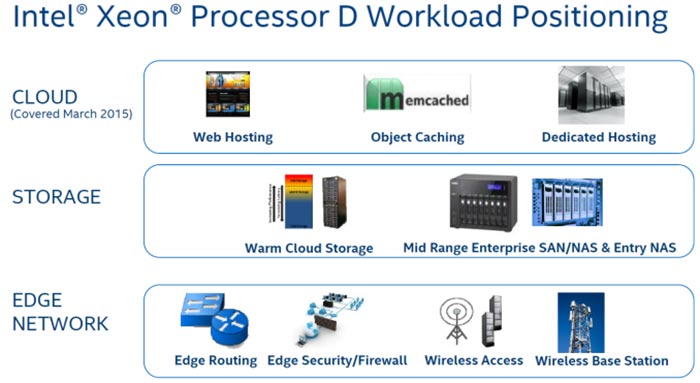
According to the Intel press release the new Xeon D SoCs offer "high-performance, low-power and twice the maximum memory of previous generations," This makes provides improved performance and lower latency and makes them eminently suitable for "various networking, cloud storage, enterprise storage and IoT applications that operate in dense, rugged environments". Intel boasts of more than 50 design wins for these new SoCs.
New Intel Ethernet controllers
There's a pair of new Ethernet Controller families. The X550 family is aimed at low-power, cost-effective 10 Gigabit Ethernet connectivity. Intel envisions it being used in data centre servers and network appliances. The Intel Ethernet Multi-host Controller FM10000 family provides up to 200Gbps of high-bandwidth multi-host connectivity and multiple 100 Gigabit Ethernet ports. It is said to deliver "exceptional packet processing capability and significantly reduces performance bottlenecks in moving network traffic within and between servers".
In addition to the above hardware introductions Intel announced that it had been selected by América Móvil, a leading Latin America mobile network operator, to upgrade its network. Furthermore Intel is now collaborating with Red Hat on the development and deployment of open, industry-standard networking solutions.
http://hexus.net/tech/news/cpu/87959...y-adds-8-skus/
-
13-11-15, 13:52 #794Tech Ubër-Dominus


- Registo
- Nov 2013
- Local
- City 17
- Posts
- 30,121
- Likes (Dados)
- 0
- Likes (Recebidos)
- 2
- Avaliação
- 1 (100%)
- Mentioned
- 0 Post(s)
- Tagged
- 0 Thread(s)
Intel Broadwell-E Specifications Leaked – Core i7-6950X Flagship Processor To Rock 10 Cores and 20 Threads, Core i7-6900K, Core i7-6850K and Core i7-6800K Detailed
First specifications for the Intel Broadwell-E CPU family have been leaked and it seems like the chip giant is once again bringing an update to the core count on their HEDT processors. The Broadwell-E lineup which is Intel’s next generation HEDT (High-End desktop) family will be based around the X99 platform and will bring new SKUs to the consumer market that will be compatible with current generation of motherboards.

Intel Broadwell-E Specifications Leaked – Core i7-6950X Rocks 10 Cores and 20 Threads
For years now, Intel has been offering quad core and even dual core options on their mainstream lineup. The multi-threading design is available on their top-tier chips but it isn’t equivalent of actual cores on the die itself. To feed the need of enthusiasts, Intel has split their lineups into two categories, the mainstream family and the enthusiast family. The mainstream family consists of parts that are focused on regular consumers with gaming, business and home uses. Now Intel has done a good job in providing some decent overclocking features with K series processors that are featured in the mainstream lineup and board partners offer some cool motherboard options to users on the platform but those who need the best performance from Intel look at the HEDT lineup which includes the high-end desktop parts ranging from top of the line chips, motherboards and I/O options.
For years, Intel has segmented their top-of-the-line processors in the HEDT family with Extreme and Unlocked series options. Starting off with the first HEDT option that was available with the Core i7-965 Extreme Edition and the Core i7-980X which launched later, Intel has released several generations of HEDT processors, each one besting the previous in a couple of ways. The Sandy Bridge, Ivy Bridge, Haswell generations have all seen their own HEDT processors from the Core i7-3960X, Core i7-4960X and the latest Core i7-5960X. The Core i7-980X was Intel’s first 6 core processor and the Core i7-5960X is Intel’s first 8 core processor. They both retailed at a launch price of $999 US but looks like Intel is going to unleash another beast soon.

The latest news on the Broadwell-E family comes straight from XFastest who have confirmed that Intel’s Core i7-6950X processor which is also the flagship processor of the Broadwell-E lineup will feature 10 cores and 20 threads. The processor will run at a base clock of 3.00 GHz followed by a turbo boost clock which is yet to be determined but I think Intel has made a point, that they are not stopping at 8 cores for their HEDT family but increasing the core count even further for consumers. The processor rocks 25 MB of L3 cache (2.5 MB per core) and will be compatible with current generation X99 motherboards that feature the LGA 2011-v3 socket. There’s no reason to believe that board partners of Intel won’t launch new motherboards to mark the arrival of the first 10 core processor from any company, whether Intel or AMD in the consumer market. Although Intel and AMD have both released higher core count processors in the server and workstation market, no 10 core high-performance CPU has yet launched in the desktop PC market.
Intel HEDT Flagship Processors (Gen vs Gen Specifications Comparison):
Based on a survey done by HWInsights a few months back, it was concluded that processors like the legacy Core i7-920, Core i7-980X and the recent Core i7-5960X are often termed as the most successful HEDT chips as they offer best value, features and high-end performance in their generation timeline.Intel HEDT Family Gulftown Sandy Bridge-E Ivy Bridge-E Haswell-E Broadwell-E Skylake-E Process Node 32nm 32nm 22nm 22nm 14nm 14nm Flagship SKU Core i7-980X Core i7-3960X Core i7-4960X Core i7-5960X Core i7-6950X Core i7-7970X (TBA) Max Cores/Threads 6/12 6/12 6/12 8/16 10/20 TBD Clock Speeds 3.33/3,60 GHz 3.30/3.90 GHz 3.60/4.00 GHz 3.00/3.50 GHz 3.00 GHz / TBD TBD Max Cache 12 MB L3 15 MB L3 15 MB L3 20 MB L3 25 MB L3 TBD Max PCI-Express Lanes 32 Gen2 40 Gen2 40 Gen3 40 Gen3 TBD TBD Chipset Compatiblity X58 Chipset X79 Chipset X79 Chipset X99 Chipset X99 Chipset New HEDT Chipset (TBA) Socket Compatiblity LGA 1366 LGA 2011 LGA 2011 LGA 2011-3 LGA 2011-3 New HEDT Socket (TBA) Memory Compatiblity DDR3-1066 DDR3-1600 DDR3-1866 DDR4-2133 DDR4-2400 DDR4-2400+ Max TDP 130W 130W 130W 140W TDP TBD Launch Q1 2010 Q4 2011 Q3 2013 Q3 2014 1H 2016 2017 Launch Price $999 US $999 US $999 US $999 US ~$999 US TBD

Image Credits: HWInsights
“When performance enthusiasts are offered an innovative and enticing new product platform, typically the most affordable and the most premium product SKUs will sell well. The Core i7 980X “Gulftown” (first enthusiast six-core) and the Core i7 5960X “Haswell-E” (first enthusiast eight-core) are both highly successful premium models priced at the $1,000 (USD) mark.The study revealed that its not higher frequency that determines the success of a high end enthusiast chip nor the price, its the features adopted by new processors. The Core i7-980X was the first CPU to feature 6 cores and had 4 MB more cache but sold at a price of $999 US. This chip, despite the insane pricing was around three-times more popular than the 975 and generated an accumulated value 41% more than the high-bar set by the 920. So far Intel to see a good response to their next generation HEDT lineup, the definitely would have to up the amount of features not only on the platform but also on their latest CPUs. The Core i7-5960X is in the same way more popular along with the more price friendly Core i7-5820K which offers 6 cores for a price of $389 which is slightly more than the Core i7-6700K or the Core i7-4790K. Similarly, the Core i7-6950X might just be another great chip despite its high price which would be around $999 US as it features a high core count for enthusiasts to utilize.
“When a new platform is not enticing, only a small group of enthusiasts will adopt the new platform, typically purchasing the least expensive full-featured model. For Sandy Bridge-E, the most popular SKU was the Core i7 3930K ($583) and for Ivy Bridge-E the more popular SKU was the Core i7 4930K ($555).” via HWInsights
Intel Core i7-6900K, Core i7-6850K and Core i7-6800K Detailed
Although the Core i7-6950X is one hell of a processor, Intel will also launch three more SKUs in the Broadwell-E lineup. This is the first time that Intel is launching four processors in an HEDT lineup but it might cover up the big price differences we have seen in the older lineups. Starting off with the Core i7-6900K which is an 8 core processor with 16 threads, 20 MB of L3 cache and a clock speed of 3.30 GHz base. The Core i7-6850K is a 6 core processor with 12 threads, 15 MB of L3 cache and a clock speed of 3.60 GHz base while the Core i7-6800K, also a 6 core processor, has 12 threads and 15 MB of L3 cache. This processor is clocked at 3.40 GHz. The TDPs for these processors are not known along with the prices but they are expected to launch later in 2016. There’s no doubt that the Core i7-6800K and Core i7-6900K will be priced around the sweet spot for enthusiasts and will mark a decent upgrade for those who are currently using the mainstream platforms. The processors will utilize higher clocked DDR4 DIMMs along with increased PCI-Express lanes and storage features that would include full compatibility with NVMe Express and 3D XPoint based Optane SSDs.
These details do sound really juicy but for now, we will treat this leak as a rumor but if anything is confirmed, Intel is definitely upping the core count on their workstation Broadwell-EP family and there’s no reason to stop at just 8 cores for the HEDT lineup.
Intel Broadwell-E Family Lineup:
Intel Broadwell-EP With Up To 22 Cores and 44 Threads Arriving In Q1 2016Processor Name Intel Core i7-6950X Intel Core i7-6900K Intel Core i7-6850K Intel Core i7-6800K Process Node 14nm 14nm 14nm 14nm Cores/Threads 10/20 8/16 6/12 6/12 Core Clock 3.00 GHz 3.30 GHz 3.60 GHz 3.40 GHz Boost Clock TBD TBD TBD TBD L3 Cache 25 MB L3 Cache 20 MB L3 Cache 15 MB L3 Cache 15 MB L3 Cache Chipset X99 X99 X99 X99 Socket LGA 2011-3 LGA 2011-3 LGA 2011-3 LGA 2011-3 Launch Price ~$999 US TBD TBD TBD TDP 140-150W 140W 140W 140W
Intel has also revealed that they have plans to officially launch Broadwell-EP Xeon E5-2600 V4 processors in Q1 2016. From previous reports, we know that Intel will still be using their Brickland and Grantley platforms for these new chips as they were supposed to span three generations of Xeon processors starting with the Ivy Bridge family. The Grantley platform which is made up of the C610 series PCH, Ethernet XL710 controller and the new Ethernet X550 controller (Sageville) will power the enterprise 1S, 2S and 4S solutions. There will additionally be DDR4 memory support as Intel makes a transition from DDR3 to DDR4 across their entire product stock from mobility processors, desktop processors and workstation/server class processors.

In terms of specifications, Broadwell-EP Xeon E5-2600 V4 processors will feature up to 22 cores while the EX series will feature up to 24 cores. The 22 core beast will feature a total of 44 threads and if we take 2.5 MB cache (per core slice) from Haswell-EP, we can expect to see up to 55 MB of L3 cache on these processors. The TDPs of the chips will range from 55 to 145 (160W Workstation only) and will be compatible with the Socket R3. The details seem to be true since it was already reported in a previously leaked slide from Intel which we covered a detailed report on. Broadwell-EP will feature up to 40 PCI-Express lanes and quad channel DDR4 memory support.
Intel Xeon Workstation/Server/Enterprise Platform Specifications:
Product Family Intel Xeon E5-2600/4600 V4 Intel Xeon E7-8800/4800 V4 Intel Xeon E5-2600/4600 V5 Intel Xeon E7-8800/4800 V5 Intel Xeon E5-2600/4600 V6 Intel Xeon E7-8800/4800 V6
Product Family Intel Xeon E5-2600/4600 V4 Intel Xeon E7-8800/4800 V4 Intel Xeon E5-2600/4600 V5 Intel Xeon E7-8800/4800 V5 Intel Xeon E5-2600/4600 V6 Intel Xeon E7-8800/4800 V6 Family Branding Broadwell-EP Broadwell-EX Skylake-EP Skylake-EX Cannonlake-EP Cannonlake-EX Process Node 14nm 14nm 14nm 14nm 10nm 10nm Xeon Platform Intel Grantley Intel Brickland Intel Purely Intel Purely Intel Purley Intel Purley PCH C610 Series C602J Series Lewisburg PCH Lewisburg PCH Lewisburg PCH Lewisburg PCH Socket Socket R1 Socket R3 Socket P Socket P Socket P Socket P Omni-Path (Interconnect) N/A N/A Storm Lake Gen1 Storm Lake Gen1 Storm Lake Gen1 Storm Lake Gen1 Max Core Count 22 24 26 (TBC) 28 30-32? 32-34? Max Thread Count 44 48 52 (TBC) 56 60-64? 64-68? Max L3 Cache 55 MB 60 MB 65 MB (TBC) 70 MB 75-80? 80-85? Max PCI-Express Lanes 40 PCI-E Gen3 32 PCI-E Gen3 48 PCI-E Gen3 48 PCI-E Gen3 >48 PCI-E Gen3 >48 PCI-E Gen3 DDR4 Memory Support 4-Channel DDR4 4-Channel DDR4 6-Channel DDR4 6-Channel DDR4 6-Channel DDR4 6-Channel DDR4 TDP Range 55-145W 115-165W 45-160W 110-160W 45-160W 110-160W Launch Expected Q1 2016 Q2 2016 1H 2017 2017 2018
-
13-11-15, 15:32 #795Master Business & GPU Man


- Registo
- Jan 2015
- Local
- País Campeão Euro 2016
- Posts
- 7,793
- Likes (Dados)
- 0
- Likes (Recebidos)
- 1
- Avaliação
- 41 (100%)
- Mentioned
- 0 Post(s)
- Tagged
- 0 Thread(s)
F###...aí vêm eles!
Ideias sem Nexo e Provas do Tráfico de Hardware
"que personifica o destino, equilíbrio e vingança divina." Dejá vú. Que cena!
Informação da Thread
Users Browsing this Thread
Estão neste momento 5 users a ver esta thread. (0 membros e 5 visitantes)





 Responder com Citação
Responder com Citação


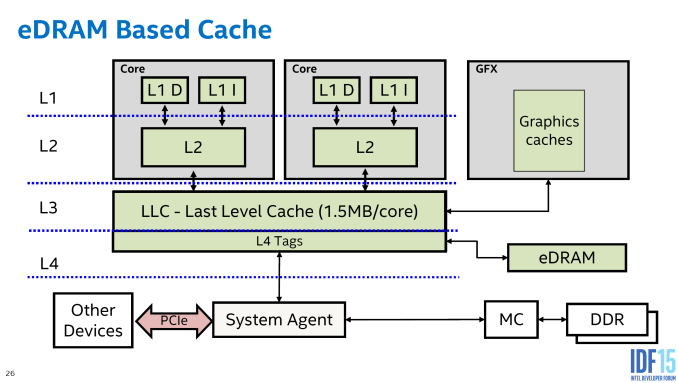
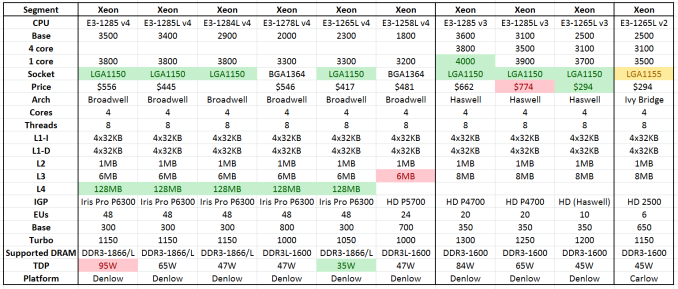
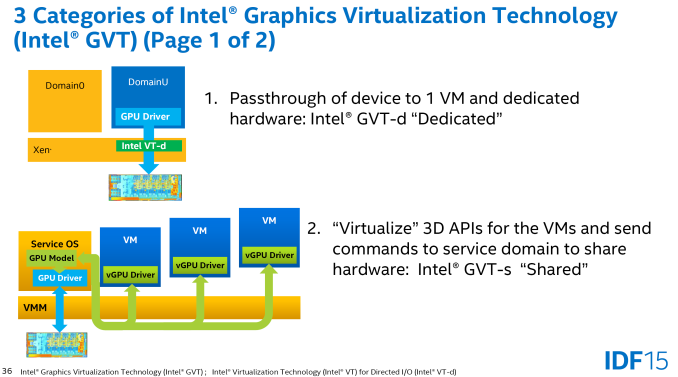
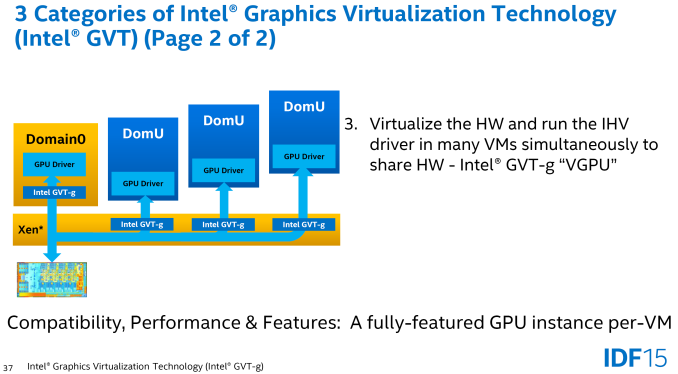
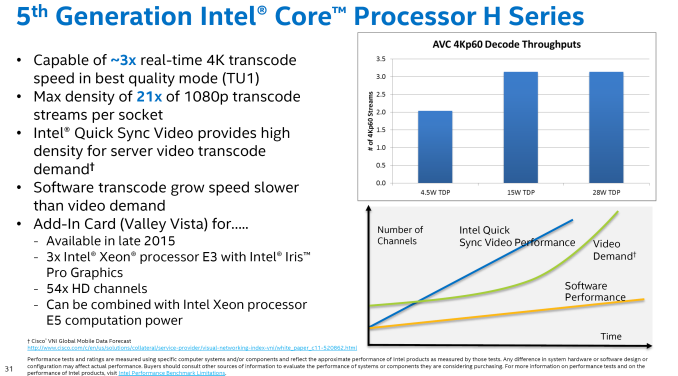
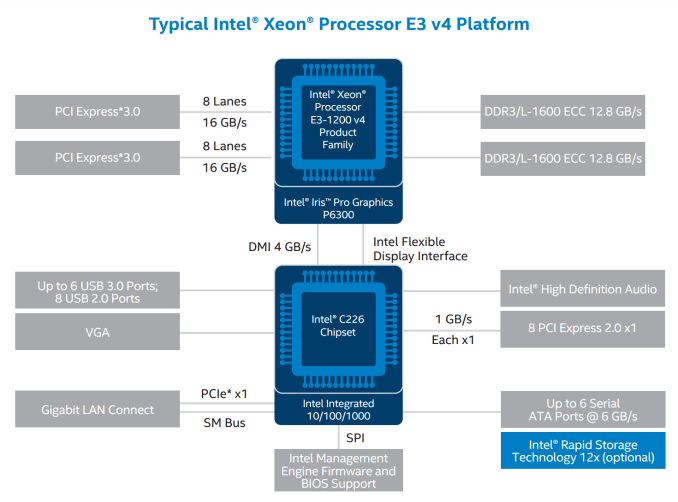



Bookmarks